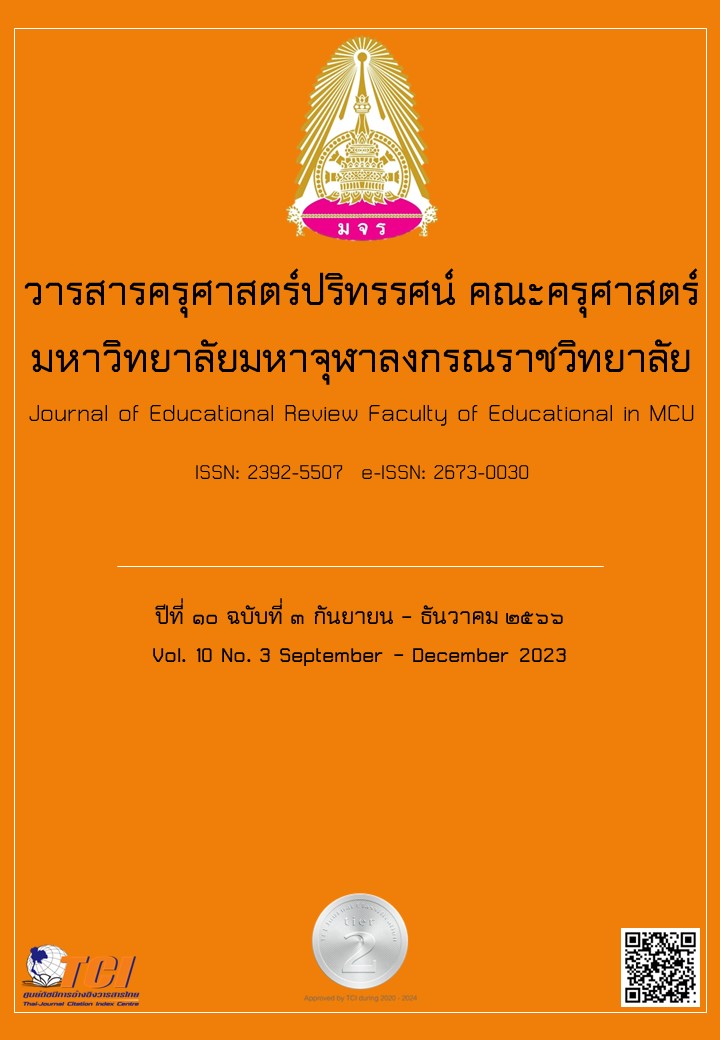INVESTIGATING NEEDS AND PROBLEMS OF DANCE EDUCATIONAL MANAGEMENT IN HIGH SCHOOL: A CASE STUDY OF TSINGHUA UNIVERSITY HIGH SCHOOL JIANGTAILU IN BEIJING
Main Article Content
Abstract
The purposes of this study were as follows: 1) To investigate the problems and needs of dance educational management in Tsinghua University High School·JIANGTAILU. 2) To propose guidelines for improving the quality of dance educational management in Tsinghua University High School·JIANGTAILU. In this study, 302 students, 78 teachers, and 40 school administrators in Tsinghua University High School JIANGTAILU were selected through stratified random sampling techniques. The research instruments used in this study included the following: 1) questionnaires with 5-point rating scales for the three sample groups; 2) focus group discussions were conducted to propose guidelines for improving the quality of dance educational management. The collected data were analyzed and presented in the form of frequency counts, percentages, average values, and standard deviations. The results of this study showed that needs of teachers and school administrators rated dance education as "the highest level" when it came to using modern technology for teaching. Students' needs for improving dance learning skills and artistic levels were also rated as "the highest level." The guideline for dance education management in Tsinghua University High School JIANGTAILU was constructed, encompassing the following: 1) Maintaining the basic principles of dance education management in senior high schools; 2) Perfecting the dance education management system; 3) Clarifying the objectives of education, teaching, and management. Through the data analysis team, the guiding document for dance education management in Tsinghua University High School JIANGTAILU was constructed, providing a reference for subsequent researchers. The main research results of this paper were as follows: 1) Dance teachers used modern educational technology and comprehensive teaching methods to conduct dance instruction; 2) Teachers had passed strict selection procedures to ensure that every dance teacher possessed professional knowledge and teaching ability.
Article Details

This work is licensed under a Creative Commons Attribution-NonCommercial-NoDerivatives 4.0 International License.
ทัศนะและความคิดเห็นที่ปรากฏในบทความในวารสารฉบับนี้ถือเป็นความรับผิดชอบของผู้เขียนบทความนั้นเพียงผู้เดียว และไม่ถือเป็นทัศนะและความรับผิดชอบของกองบรรณาธิการ
กองบรรณาธิการขอสงวนสิทธิ์ในการคัดเลือกบทความลงตีพิมพ์และจะแจ้งให้เจ้าของบทความทราบหลังจากผู้ประเมินบทความตรวจอ่านบทความแล้ว
ต้นฉบับที่ได้รับการตีพิมพ์ในวารสารครุศาสตร์ปริทรรศน์ คณะครุศาสตร์ มหาวิทยาลัยมหาจุฬาลงกรณราชวิทยาลัย ถือเป็นกรรมสิทธิ์ของคณะครุศาสตร์ มหาวิทยาลัยมหาจุฬาลงกรณราชวิทยาลัย ห้ามนำข้อความทั้งหมดหรือบางส่วนไปพิมพ์ซ้ำ เว้นเสียแต่ว่าจะได้รับอนุญาตจากมหาวิทยาลัยฯ เป็นลายลักษณ์อักษร
References
Beserra, V. et al. (2021). Teaching through dance: An opportunity to introduce physically active academic lessons. Teaching and Teacher Education. 106. doi.org/10.1016/j.tate.2021.103450
Cremades-Andreu, R., & Lage-Gómez, C. (2023). Different forms of students’ motivation and musical creativity in secondary school. British Journal of Music Education. 1-11. doi: 10.1017/S0265051723000232
Engdahl, C., Lundvall, S. and Barker, D. (2021). Free but not free-free’: teaching creative aspects of dance in physical education teacher education. Physical Education and Sport Pedagogy. 1-13. doi: 10.1080/17408989.2021.2014435
Grindheim, M. and Grindheim, L.T. (2021). Dancing as Moments of Belonging: A Phenomenological Study Exploring Dancing as a Relevant Activity for Social and Cultural Sustainability in Early Childhood Education. Sustainability. 13(14). 8080.
Katja Köngäs, Kaarina Määttä & Satu Uusiautti. (2022). Leadership in change in dance education: experiences of principals in Finnish dance education institutes. International Journal of Leadership in Education. 1-8. doi: 10.1080/13603124.2022.2045632
Levenberg, M., Armstrong, T. and Johnson, I. (2020). Teaching Dance for Understanding: Reconceptualizing Dance in Physical Education, Journal of Physical Education. Recreation & Dance. 91(6). 3-7.
Mattsson, T. and Larsson H. (2021). ‘There is no right or wrong way': exploring expressive dance assignments in physical education. Physical Education and Sport Pedagogy. 26(2). 123-136.
Panagiotopoulou, E. (2018). Dance therapy and the public school: The development of social and emotional skills of high school students in Greece. The Arts in Psychotherapy. 59. 25-33. doi.org/10.1016/j.aip.2017.11.003
Petrie, J. L. (2020). Advancing student success: Assessing the educational outcomes of music and dance education in Ghanaian senior high schools. Compare: A Journal of Comparative and International Education. 50(3). 332-351.
Yamane, T. (1973). Statistics: An Introductory Analysis. London: John Weather Hill, Inc.


